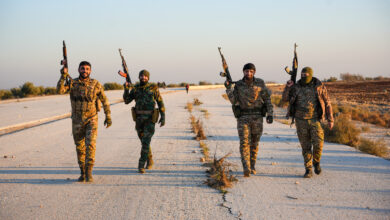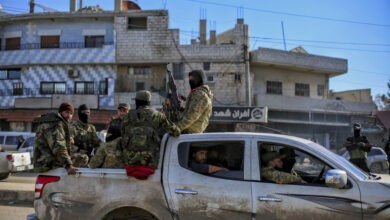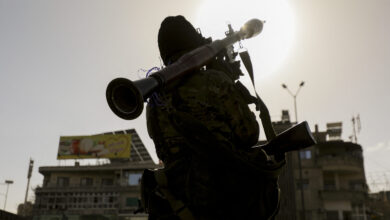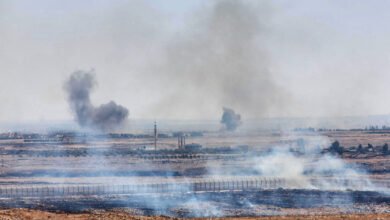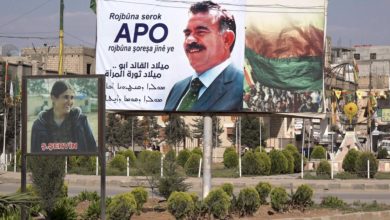Khan Sheikhoun a ghost town as Syrian regime advances
As the Syrian government inches closer to retaking rebel-held Khan Sheikhoun, the once-vibrant town in southern Idlib province is now largely abandoned.
Ahead of an expected regime assault on their hometown, residents have emptied out of Khan Sheikhoun and fled to the relative safety of areas further north. On Sunday night, the Syria Civil Defense workers known as the White Helmets helped evacuate the remaining families.
“The children were so afraid,” Hamid Qutini, a search-and-rescue volunteer, said. “We gave them cookies and tried to assure them that we would take them far away from the sounds of the explosions.”
Families in need of transport flagged the White Helmets down in their neighborhoods or contacted them on the online messaging service WhatsApp. Qutini describes seeing scores of frightened children, many of them orphans, clutching their blankets and pillows.
“This isn’t their fault,” Qutini said. “I felt so helpless that I couldn’t stop the bombings for them.”
Under the cover of darkness, Qutini and other volunteers drove the families to neighboring al-Dana, Atmeh and Idlib city.
With the nearby Turkish border closed to refugees, many of the displaced are now living in olive groves and sheltering beneath trees. Others are packed into overcrowded displacement camps.

Ziad Abboud, head of the White Helmets organization in Khan Sheikhoun, said his team rescued 90 residents earlier this week. They’re now focused on evacuating the northern countryside, including the towns of Hesh, Alteh and Kafar Sijnah.
“God willing, we will try to help them all,” Abboud said.
Since late April, forces loyal to President Bashar al-Assad have fought to wrest control of Idlib province which, along with parts of northern Hama, is the country’s last opposition stronghold after eight years of civil war.
The latest round of fighting near Khan Sheikhoun comes after the collapse of a brief ceasefire brokered by Syria’s main allies, Russia and Iran, and neighboring Turkey, which backs the opposition.
More than three million people are packed into the northwestern enclave. Nearly half are displaced from fighting elsewhere in the country.
Since late April, Russian and Syrian aerial attacks have pummeled Idlib, which is dominated by the al-Qaida-linked Hayat Tahrir al-Sham (HTS) group. The violence has killed at least 450 civilians and forced hundreds of thousands to flee their homes, according to the United Nations.
Rights groups accuse the regime and its ally Russia of intentionally striking civilian areas, which they deny. Earlier this month, U.N. Secretary-General António Guterres called for an internal U.N. investigation into the targeting of hospitals and other civilian infrastructure in the densely populated region.
Khan Sheikhoun is of strategic importance. The town sits on what was once a vital commercial highway connecting the large northern city of Aleppo to the capital of Damascus.
The town is also symbolically significant. Khan Sheikhoun captured headlines in April 2017 when a sarin gas attack blamed on the regime killed some 90 people, including children. President Donald Trump ordered retaliatory missile strikes on Shayrat airbase from where the attack was likely launched.
Early on Wednesday Syria’s pro-opposition STEP News Agency reported that pro-regime forces had captured the village of Tal Aas, less than 5 km (3.1 miles) west of Khan Sheikhoun.
U.K.-based Syrian Observatory for Human Rights reported troops loyal to Assad were just a few kilometers away from Khan Sheikhoun. Pro-government forces captured the village of al-Hobeit and made gains on the towns of Morek, Kafr Zeita and Latamneh, according to state news agency SANA and opposition activists.
“Russia is practicing a scorched-earth policy, paving the way for Assad’s troops,” said Captain Naji Mustafa, spokesperson for the Turkey-backed National Liberation Front rebel coalition.

Despite advancing from multiple axes, regime troops have taken some hits, Mustafa says.
“They haven’t been able to achieve their strategy so far, and the rebels are determined to resist them,” he told The Defense Post.
Mohammed Salloum was the last in his family to flee. His plan was to stay behind to keep watch over their house in Khan Sheikhoun, but then the aerial bombardment picked up.
“The barrel bombs were falling all around,” he said. “It was terrifying and I tried to get used to it, hoping it would stop.”
On Thursday, Salloum tossed his computer, camera and phone into a backpack, locked the door behind him and got on his motorcycle. On his way north to al-Dana, he passed rows of eerily quiet streets.
“There is no substitute for the former beauty of my city,” said Salloum. “Now, Khan Sheikhun is a ghost town,” said Salloum.
Salloum is currently living in a small, three-bedroom house he is sharing his parents, his three brothers and their families in al-Dana. None of them have found jobs in their new city and are struggling to pay the $100 owed each month in rent. Salloum hopes their situation is just temporary.
“There really is nothing harder than leaving your home.”



